Climate Sensitivity and Feedback of a New Coupled Model (K-ACE) to Idealized CO2 Forcing
Abstract
:1. Introduction
2. Model Experiment and Methodology
3. Results
3.1. Climate Sensitivity to Idealized CO2 Change
3.2. Decomposition of Radiative Feedabck
3.2.1. Clear-Sky Feedback
3.2.2. CRE Feedback
3.3. Cloud Properties Related to CRE Feedback
3.3.1. Low-Level Cloud Amount
3.3.2. Higher Altitude Cloud
4. Conclusions
- In the idealized CO2 experiment, temperature rising in K-ACE is larger than in the CMIP5 ensemble mean. The ECS of K-ACE calculated by Gregory et al. [48] is 4.83 K, substantially higher than the range of CMIP5 of 2.1–4.7 K and the higher bound of 1.8–5.6 K of CMIP6 models.
- Radiative feedback is decomposed by clear-sky and cloud radiative feedback effects. Under clear skies, λSWCS and λLWCS are within the range of CMIP5 and CMIP6 models. Meanwhile, CRE feedback of K-ACE shows large amplitude. SW and LW components of CRE feedback (λSWCRE, λLWCRE) tend toward the higher and lower end of the range of CMIP5 and CMIP6 models.
- Based on the cloud characteristics of K-ACE, less ice cloud in mid-latitudes (decreasing albedo, more surface warming) and less low-level cloud in the tropics (increasing temperature produces less low clouds, more incoming radiation, and increased warming) contribute to a stronger λSWCRE and higher ECS.
- For high-level cloud, cloud characteristics of K-ACE (more high cloud due to the moistening in the upper tropical troposphere) contribute to less outgoing LW. In addition, the global pattern of λLWCRE (Figure 6d) and cloud feedback (Figure 8a) is spatially similar. This infers that higher cloud formation of K-ACE compared to CMIP5 models contributes to stronger λLWCRE, which could cause higher ECS.
Author Contributions
Funding
Conflicts of Interest
References
- Stocker, T.F.; Qin, D.; Plattner, G.K.; Tignor, M.; Allen, S.K.; Boschung, J.; Nauels, A.; Xia, Y.; Bex, V.; Midgley, P.M.; et al. Climate Change, 2013: The Physical Science Basis. Contribution of Working Group I to the Fifth Assessment Report of the Intergovernmental Panel on Climate Change; Technical Summary; Cambridge University Press: Cambridge, UK; New York, NY, USA, 2013; p. 1535. [Google Scholar]
- Held, I.M.; Soden, B.J. Water vapor feedback and global warming. Annu. Rev. Energy Environ. 2000, 25, 441–475. [Google Scholar] [CrossRef] [Green Version]
- Randall, D.A.; Wood, R.A.; Bony, S.; Colman, R.; Fichefet, T.; Fyfe, J.; Kattsov, V.; Pitman, A.; Shukla, J.; Srinivasan, J.; et al. Climate models and their evaluation. In Climate Change 2007: The Physical Science Basis. Contribution of Working Group I to the Fourth Assessment Report of the Intergovernmental Panel on Climate Change; Solomon, S., Qin, D., Manning, M., Chen, Z., Marquis, M., Averyt, K.B., Tignor, M., Miller, H.L., Eds.; Cambridge University Press: Cambridge, UK; New York, NY, USA, 2007; p. 996. [Google Scholar]
- Boucher, O.; Randall, D.; Artaxo, P.; Bretherton, C.; Feingold, G.; Forster, P.; Kerminen, V.M.; Kondo, Y.; Liao, H.; Lohmann, U.; et al. Clouds and aero- sols. In Climate Change 2013: The Physical Science Basis. Contribution of Working Group I to the Fifth Assessment Report of the Intergovernmental Panel on Climate Change; Stocker, T.F., Qin, D., Plattner, G.K., Tignor, M., Allen, S.K., Doschung, J., Nauels, A., Xia, Y., Bex, V., Midgley, P.M., Eds.; Cambridge University Press: Cambridge, UK; New York, NY, USA, 2013; pp. 571–658. [Google Scholar]
- Stephens, G.L. Cloud feedbacks in the climate system: A critical review. J. Clim. 2005, 18, 237–273. [Google Scholar] [CrossRef] [Green Version]
- Ceppi, P.; Brient, F.; Zelinka, M.D.; Hartmann, D.L. Cloud feedback mechanisms and their representation in global climate models. WIREs Clim. Chang. 2017, 8, e465. [Google Scholar] [CrossRef]
- Chen, X.; Guo, Z.; Zhou, T.; Li, J.; Rong, X.; Chen, H.; Su, J. Climate sensitivity and feedbacks of a new coupled model CAMS-CSM to idealized CO2 forcing: A Comparison with CMIP5 models. J. Meteor. Res. 2019, 31, 31–45. [Google Scholar] [CrossRef]
- Matthews, H.D.; Gillett, N.P.; Stott, P.A.; Zickfeld, K. The proportionality of global warming to cumulative carbon emissions. Nature 2009, 459, 829–832. [Google Scholar] [CrossRef]
- Collins, M.; Knutti, R.; Arblaster, J.; Dufresne, J.L.; Fichefet, T.; Friedlingstein, P.; Gao, X.; Gutowski, W.J.; Johns, T.; Krinner, G.; et al. Long-term climate change: Projections, commitments and irreversibility. In Climate Change 2013: The Physical Science Basis. Contribution of Working Group I to the Fifth Assessment Report of the Intergovernmental Panel on Climate Change; Stocker, T.F., Qin, D., Plattner, G.-K., Tignor, M.M.B., Allen, S.K., Boschung, J., Nauels, A., Xia, Y., Bex, V., Midgley, P.M., Eds.; Cambridge University Press: Cambridge, UK; New York, NY, USA, 2013; pp. 1029–1136. [Google Scholar]
- Rogelj, J.; Meinshausen, M.; Sedlacek, J.; Knutti, R. Implications of potentially lower climate sensitivity on climate projections and policy. Environ. Res. Lett. 2014, 9, 031003. [Google Scholar] [CrossRef]
- Millar, R.J.; Fuglestvedt, J.S.; Friedlingstein, P.; Rogelj, J.; Grubb, M.J.; Matthews, H.D.; Skeie, R.B.; Forster, P.M.; Frame, D.J.; Allen, M.R. Emission budgets and pathways consistent with limiting warming to 1.5 °C. Nat. Geosci. 2017, 10, 741–747. [Google Scholar] [CrossRef]
- Goodwin, P.; Katavouta, A.; Roussenov, V.M.; Foster, G.L.; Rohling, E.J.; Williams, R.G. Pathway to 1.5 °C to 2 °C warming based on observational and geological constraints. Nat. Geosci. 2018, 11. [Google Scholar] [CrossRef]
- Charney, J.G.; Arakawa, A.; Baker, D.J.; Bolin, B.; Dickinson, R.E.; Goody, R.M.; Leith, C.E.; Stommel, H.M.; Wunsch, C.I. Carbon Dioxide and Climate: A Scientific Assessment; National Academy of Sciences: Washington, DC, USA, 1979; p. 22. [Google Scholar]
- Vial, J.; Dufresne, J.L.; Bony, S. On the interpretation of inter-model spread in CMIP5 climate sensitivity estimates. Clim. Dyn. 2013, 41, 3339–3362. [Google Scholar] [CrossRef]
- Cox, P.M.; Huntingford, C.; Williamson, M.S. Emergent constraint on equilibrium climate sensitivity from global temperature variability. Nature 2018, 553, 319–322. [Google Scholar] [CrossRef] [PubMed]
- Roe, G.H.; Armour, K.C. How sensitive is climate sensitivity? Geophys. Res. Lett. 2011, 38, L14708. [Google Scholar] [CrossRef]
- Knutti, R.; Rugenstein, M.A.; Hegerl, G.C. Beyond equilibrium climate sensitivity. Nat. Geosci. 2017, 10, 727–736. [Google Scholar] [CrossRef]
- Taylor, K.E.; Stouffer, R.J.; Meehl, G.A. An Overview of CMIP5 and Experiment Design. Bull. Amer. Meteor. Soc. 2012, 93, 485–498. [Google Scholar] [CrossRef] [Green Version]
- Stocker, T.F.; Qin, D.; Plattner, G.-K.; Tignor MM, B.; Allen, S.K.; Boschung, J.; Nauels, A.; Xia, Y.; Bex, V.; Midgley, P.M. (Eds.) IPCC: Summary for policymakers. In Climate Change 2013: The Physical Science Basis. Contribution of Working Group I to the Fifth Assess- Ment Report of IPCC the Intergovernmental Panel on Climate Change; Cambridge University Press: Cambridge, UK; New York, NY, USA, 2014; pp. 3–29. [Google Scholar]
- Voldoire, A.; Saint-Martin, D.; Sénési, S.; Decharme, B.; Alias, A.; Chevallier, M.; Colin, J.; Guérémy, J.F.; Michou, M.; Moine, M.P.; et al. Evaluation of CMIP6 DECK Experiments with CNRM-CM6-1. J. Adv. Model. Earth Syst. 2019, 11, 2177–2213. [Google Scholar] [CrossRef] [Green Version]
- Wyser, K.; van Noije, T.; Yang, S.; von Hardenberg, J.; O’Donnell, D.; Dosche, R. On the increased climate sensitivity in the EC-Earth model from CMIP5 to CMIP6. Geosci. Model Dev. 2020, 13, 3465–3474. [Google Scholar] [CrossRef]
- Andrews, T.; Andrews, M.B.; Bodas-Salcedo, A.; Jones, G.S.; Kuhlbrodt, T.; Manners, J.; Menary, M.B.; Ridley, J.; Ringer, M.A.; Sellar, A.A.; et al. Forcings, Feedbacks, and Climate Sensitivity in HadGEM3-GC3.1 and UKESM1. J. Adv. Model. Earth Syst. 2019, 11, 4377–4394. [Google Scholar] [CrossRef] [Green Version]
- Gettelman, A.; Hannay, C.; Bacmeister, J.T.; Neale, R.B.; Pendergrass, A.G.; Danabasoglu, G.; Lamarque, J.F.; Fasullo, J.T.; Bailey, D.A.; Lawrence, D.M.; et al. High climate sensitivity in the Community Earth System Model Version 2 (CESM2). Geophys. Res. Lett. 2019, 46, 8329–8337. [Google Scholar] [CrossRef]
- Golaz, J.C.; Caldwell, P.M.; Van Roekel, L.P.; Petersen, M.R.; Tang, Q.; Wolfe, J.D.; Abeshu, G.; Anantharaj, V.; Asay-Davis, X.S.; Bader, D.C.; et al. The DOE E3SM coupled model version1: Overview and evaluation at standard resolution. J. Adv. Model. Earth Syst. 2019, 11, 2089–2129. [Google Scholar] [CrossRef]
- Zelinka, M.D.; Myers, T.A.; McCoy, D.T.; Po-Chedley, S.; Caldwell, P.M.; Ceppi, P.; Klein, S.A.; Taylor, K.E. Causes of higher climate sensitivity in CMIP6 models. Geophys. Res. Lett. 2020, 47, e2019GL085782. [Google Scholar] [CrossRef] [Green Version]
- Dong, Y.; Armour, K.C.; Zelinka, M.D.; Proistosescu, C.; Battisti, D.S.; Zhou, C.; Andrews, T. Intermodel Spread in the pattern effect and its contribution to climate sensitivity in CMIP5 and CMIP6 models. J. Clim. 2020, 33. [Google Scholar] [CrossRef]
- Meehl, G.A.; Senior, C.A.; Eyring, V.; Flato, G.; Lamarque, J.-F.; Stouffer, R.J.; Taylor, K.E.; Schlund, M. Context for interpreting equilibrium climate sensitivity and transient climate response from the CMIP6 Earth system models. Sci. Adv. 2020, 6, eaba1981. [Google Scholar] [CrossRef] [PubMed]
- Williams, R.G.; Ceppi, P.; Katavouta, A. Controls of the transient climate response to emissions by physical feedbacks, heat uptake and carbon cycling. Environ. Res. Lett. 2020, 15. [Google Scholar] [CrossRef]
- Tokarska, K.B.; Stope, M.B.; Sippel, S.; Fisher, E.M.; Smith, C.J.; Lehner, F.; Knutti, R. Past warming trend constrains future warming in CMIP6 models. Sci. Adv. 2020, 6, eaaz9549. [Google Scholar] [CrossRef] [PubMed] [Green Version]
- Flynn, C.M.; Mauritsen, T. On the climate sensitivity and historical warming evolution in rescent coupled model ensembles. Atmos. Chem. Phys. 2020, 20, 7829–7842. [Google Scholar] [CrossRef]
- Sung, H.M.; Kim, J.; Shim, S.; Seo, J.; Kwon, S.-H.; Sun, M.-A.; Moon, H.; Lee, J.-H.; Lim, Y.-J.; Boo, K.-O.; et al. Evaluation of NIMS/KMA CMIP6 model and future climate change scenarios based on new GHGs concentration pathways. APJAS 2020, 56. [Google Scholar] [CrossRef]
- Senior, C.A.; Andrews, T.; Burton, C.; Chadwick, R.; Copsey, D.; Graham, T. Idealized climate change simulations with a high-resolution physical model: HadGEM3-GC2. J. Adv. Model. Earth Syst. 2016, 8, 813–830. [Google Scholar] [CrossRef]
- Williams, K.D.; Copsey, D.; Blockley, E.W.; Bodas-Salcedo, A.; Calvert, D.; Comer, R.; Davis, P.; Graham, T.; Hewitt, H.T.; Hill, R.; et al. The Met Office Global Coupled model 3.0 and 3.1 (GC3.0 and GC3.1) configurations. J. Adv. Model. Earth Syst. 2017, 10, 357–380. [Google Scholar] [CrossRef]
- Lee, J.; Kim, J.; Sun, M.-A.; Kim, B.-H.; Moon, H.; Sung, H.M.; Kim, J.; Lim, Y.-J.; Byun, Y.-H. Evaluation of the Korea Meteorological Administration Advanced Community Earth-system model (K-ACE). Asia-Pac. J. Atmos. Sci. 2020, 56, 381–395. [Google Scholar] [CrossRef] [Green Version]
- Walters, D.; Baran, A.J.; Boutle, I.; Brooks, M.; Earnshaw, P.; Edwards, J.; Furtado, K.; Hill, P.; Lock, A.; Manners, J.; et al. The Met Office Unified Model Global Atmosphere 7.0/7.1 and JULES Global Land 7.0 configurations. Geosci. Model Dev. 2019, 12, 1909–1963. [Google Scholar] [CrossRef] [Green Version]
- Wood, N.; Staniforth, A.; White, A.; Allen, T.; Diamantakis, M.; Gross, M.; Melovin, T.; Smith, C.; Vosper, S.; Zerroukat, M.; et al. An inherently mass-conserving semi-implicit semi-Lagrangian discretization of the deep-atmosphere global non-hydrostatic equations. Q. J. R. Meteorol. Soc. 2014, 140, 1505–1520. [Google Scholar] [CrossRef]
- Edwards, J.M.; Slingo, A. Studies with a flexible new radiation code. I: Choosing a configuration for a large-scale model. Q. J. R. Meteorol. Soc. 1996, 122, 689–719. [Google Scholar] [CrossRef]
- Mann, G.W.; Carslaw, K.S.; Spracklen, D.V.; Ridley, D.A.; Manktelow, P.T.; Chipperfield, M.P.; Pickering, S.J.; Johnson, C.E. Description and evaluation of GLOMAP-mode: A modal global aerosol micro- physics model for the UKCA composition-climate model. Geosci. Mod. Dev. 2010, 3, 519–551. [Google Scholar] [CrossRef] [Green Version]
- Bellouin, N.; Mann, G.W.; Woodhouse, M.T.; Johnson, C.; Carslaw, K.S.; Dalvi, M. Impact of the modal aerosol scheme GLOMAP-mode on aerosol forcing in the Hadley Centre Global Environmental Model. Atmos. Chem. Phys. 2013, 13, 3027–3044. [Google Scholar] [CrossRef] [Green Version]
- Griffies, S.M. A Technical Guide to MOM, GFDL Ocean Group Technical Report No. 5; NOAA/Geophysical Fluid Dynamics Laboratory: Princeton, NJ, USA, 2007.
- Hunke, E.C.; Lipscomb, W.H.; Turner, A.K.; Jeffery, N.; Elliott, S. CICE: The Los Alamos Sea Ice Model Documentation and Software User’s Manual, Techical Report, LA-CC-06-012; Los Alamos National Laboratory: Los Alamos, NM, USA, 2015.
- Craig, A.; Valcke, S.; Coquart, L. Development and performance of a new version of the OASIS coupler, OASIS3-MCT_3.0. Geosci. Model Dev. 2017, 10, 3297–3308. [Google Scholar] [CrossRef] [Green Version]
- Valcke, S.; Craig, T.; Coquart, L. OASIS3-MCT User Guide, OASIS3-MTC_3.0, Technical Report; TR/CMGC/15/38, CERFACS No1875; CNRS SUC URA: Toulouse, France, 2015; Available online: https://portal.enes.org/oasis/metrics/oasis4-dissemination (accessed on 29 August 2020).
- Wilson, D.R.; ABushell, C.; Kerr-Munslow, A.M.; Price, J.D.; Morcrette, C.J. PC2: A prognostic cloud fraction and condensation scheme. I: Scheme description. Q. J. R. Meteorol. Soc. 2008, 134, 2093–2107. [Google Scholar] [CrossRef]
- Wilson, D.R.; Bushelll, A.C.; Kerr-Munslow, A.M.; Price, J.D.; Morcrette, C.J.; Bodas-Salcedo, A. PC2: A prognostic cloud fraction and condensation scheme. ii: Climate model simulations. Q. J. R. Meteorol. Soc. 2008, 134, 2109–2125. [Google Scholar] [CrossRef]
- Smith, R.N.B. A scheme for predicting layer clouds and their water content in a general circulation model. Q. J. R. Meteorol. Soc. 1990, 116, 435–460. [Google Scholar] [CrossRef]
- Eyring, V.; Bony, S.; Meehl, G.A.; Senior, C.A.; Stevens, B.; Stouffer, R.J.; Taylor, K.E. Overview of the Coupled Model Intercomparison Project Phase 6 (CMIP6) experimental design and organization. Geosci. Model Dev. 2016, 9, 1937–1958. [Google Scholar] [CrossRef] [Green Version]
- Gregory, J.M.; Ingram, W.J.; Palmer, M.A.; Jones, G.S.; Stott, P.A.; Thorpe, R.B.; Lowe, J.A.; Johns, T.C.; Williams, K.D. A new method for diagnosing radiative forcing and climate sensitivity. Geophys. Res. Lett. 2004, 31, L03205. [Google Scholar] [CrossRef] [Green Version]
- Flato, G.; Marotzke, J.; Abiodun, B.; Braconnot, P.; Chou, S.C.; Collins, W.; Cox, P.; Driouech, F.; Emori, S.; Eyring, V.; et al. Evaluation of Climate Models. In Climate Change 2013: The Physical Science Basis. Contribution of Working Group I to the Fifth Assessment Report of Intergovernmental Panel on Climate Change; Stocker, F.T., Qin, D., Plattner, G.-K., Tignor, M., Allen, S.K., Boschung, J., Nauels, A., Xia, Y., Bex, V., Midgley, P.M., Eds.; Cambridge University Press: Cambridge, UK; New York, NY, USA, 2013; pp. 819–820. [Google Scholar]
- Dufresne, J.L.; Bony, S. An assessment of the primary sources of spread of global warming estimates from coupled atmosphere-ocean models. J. Clim. 2008, 21, 5135–5144. [Google Scholar] [CrossRef] [Green Version]
- Soden, B.J.; Held, I.M. An assessment of climate feedbacks in coupled ocean-atmosphere models. J. Clim. 2006, 19, 3354–3360. [Google Scholar] [CrossRef]
- Webb, M.J.; Lambert, F.H.; Gregory, J.M. Origins of differences in climate sensitivity, forcing and feedback in climate models. Clim. Dyn. 2013, 40, 677–707. [Google Scholar] [CrossRef]
- Cao, J.; Wang, B.; Yang, Y.-M.; Ma, L.; Li, J.; Sun, B.; Bao, Y.; He, J.; Zhou, X.; Wu, L. The NUIST Earth System Model (NESM) version3: Description and preliminary evaluation. Geosci. Model Dev. 2018, 11, 2975–2993. [Google Scholar] [CrossRef] [Green Version]
- Andrews, T.; Gregory, J.M.; Webb, M.J.; Taylor, K.E. Forcing, feedbacks and climate sensitivity in CMIP5 coupled atmosphere-ocean climate models. Geophys. Res. Lett. 2012, 39, L09712. [Google Scholar] [CrossRef] [Green Version]
- Yokohata, T.; Emori, S.; Nozawa, T.; Ogura, T.; Kawamiya, M.; Tsushima, Y.; Suzuki, T.; Yukimoto, S.; Abe-Ouchi, A.; Hasumi, H.; et al. Comparison of equilibrium and transient responses to CO2 increase in eight state-of-the-art climate models. Tellus A 2008, 60, 946–961. [Google Scholar] [CrossRef]
- Grise, K.M.; Medeiros, B. Understanding the varied influence of mid-latitude jet position on clouds and cloud radiative effects in observations and global climate models. J. Clim. 2016, 20, 9005–9025. [Google Scholar] [CrossRef]
- Kelleher, M.K.; Grise, K.M. Examining Southern Ocean cloud controlling factors on daily time scales and their connections to mid-latitude weather systems. J. Clim. 2019, 32, 5145–5160. [Google Scholar] [CrossRef]
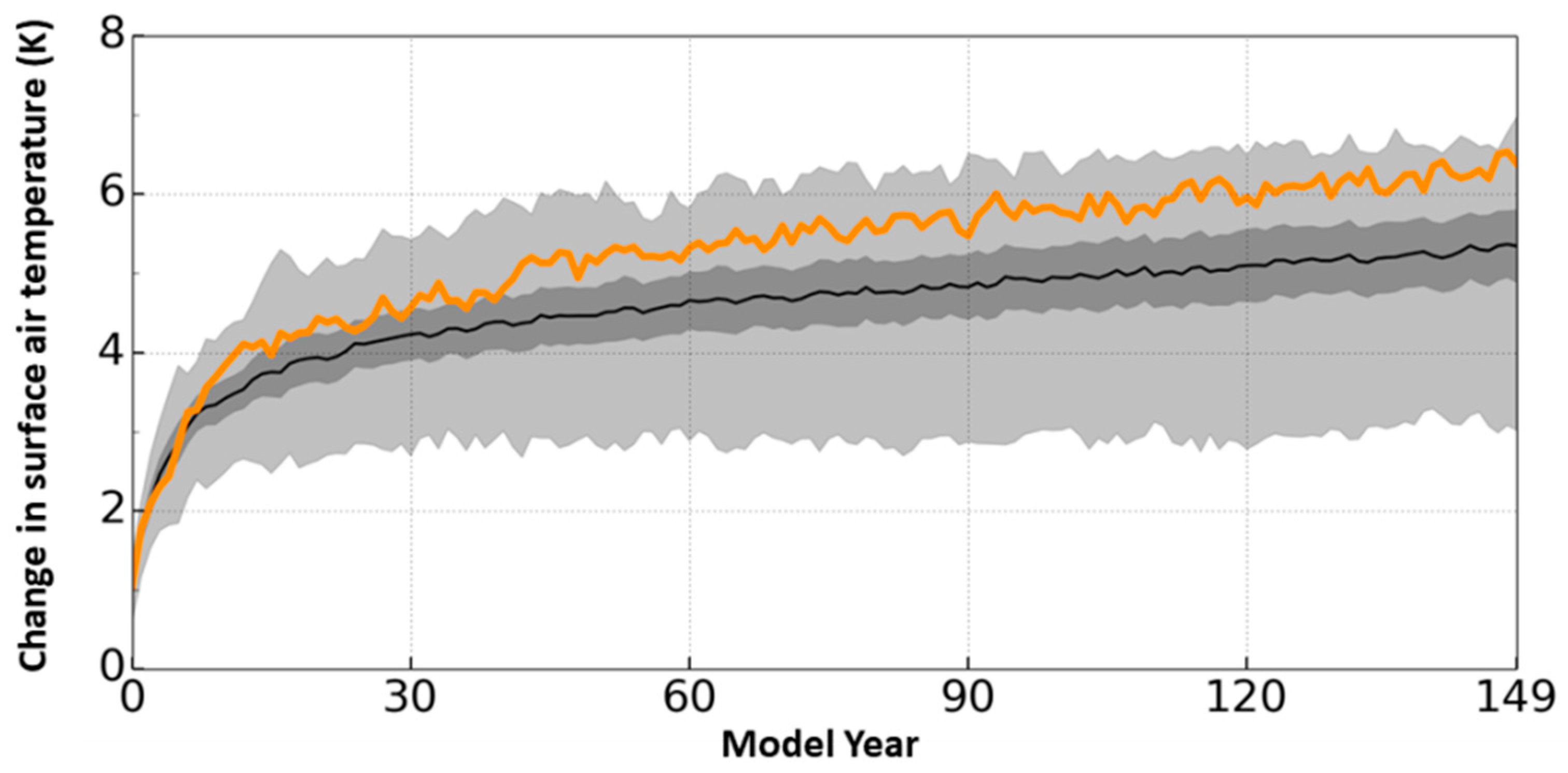
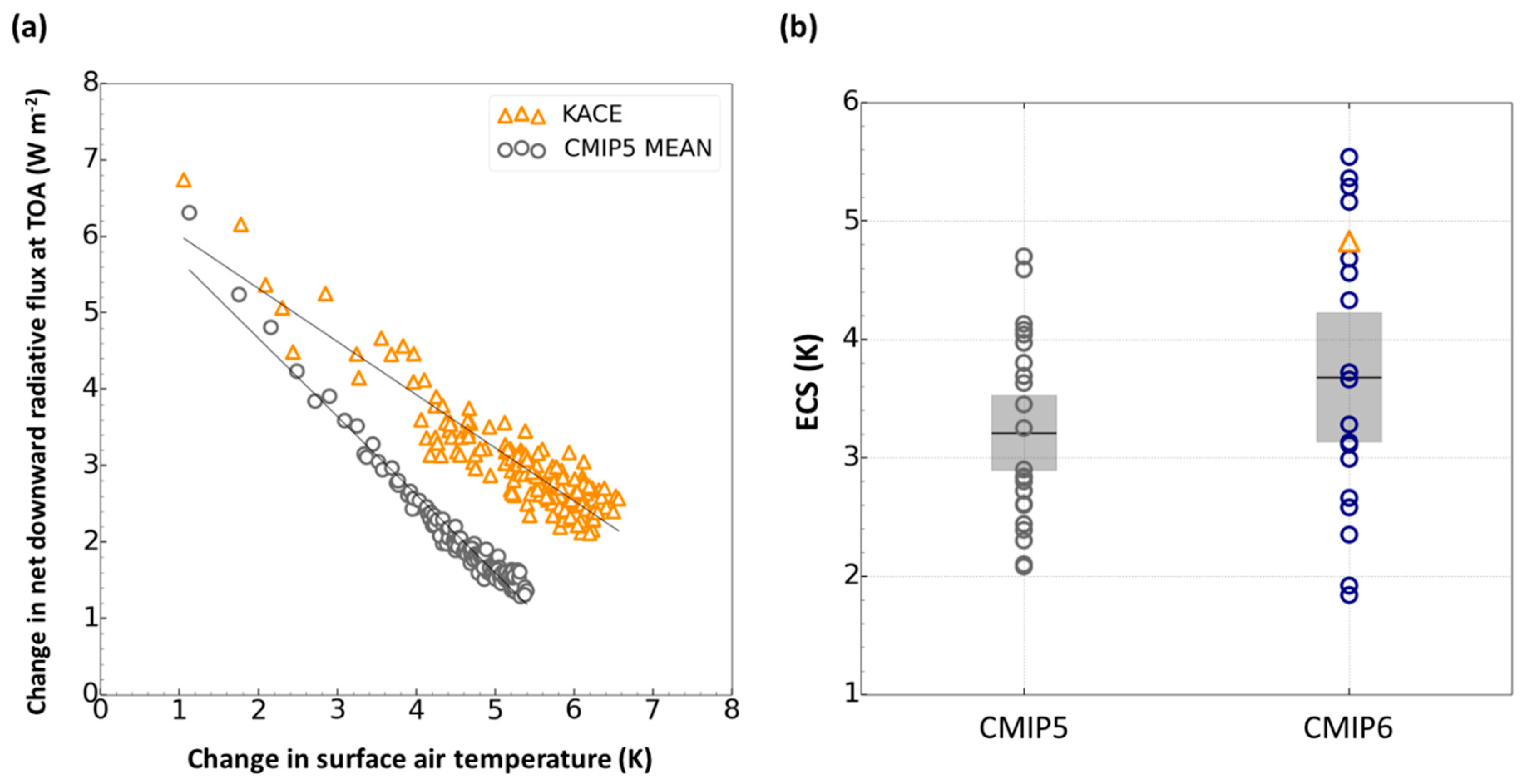
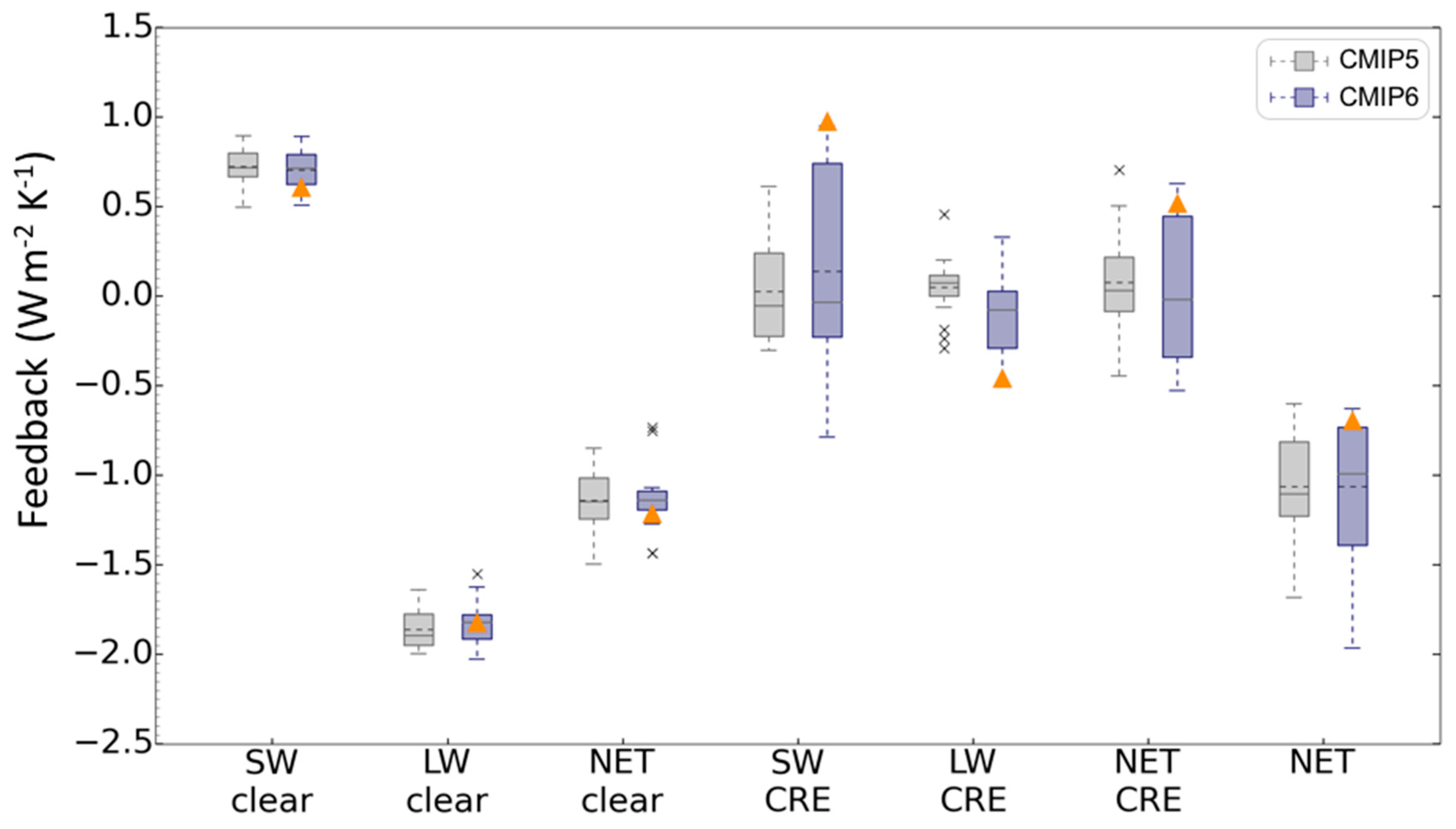

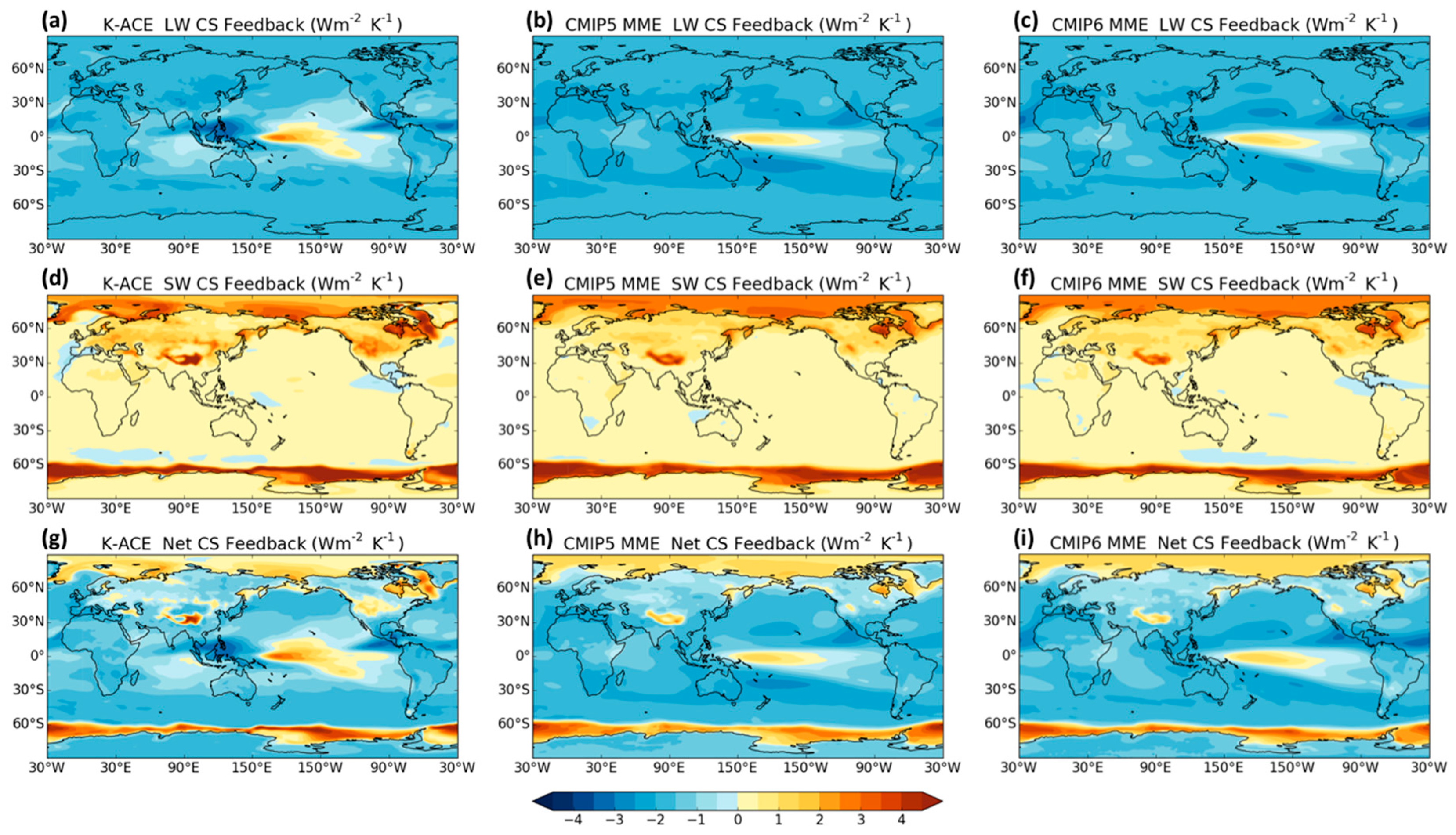
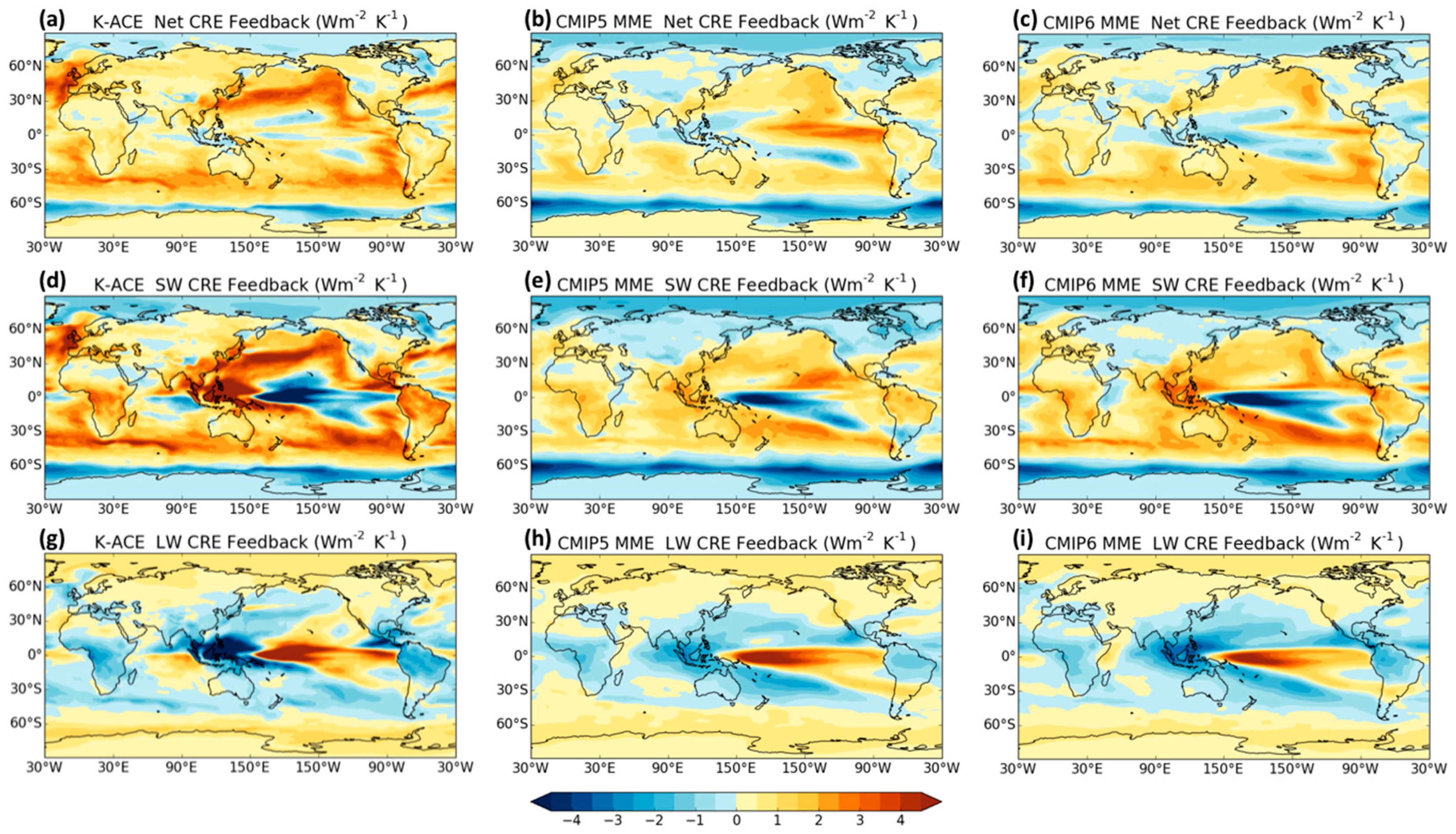
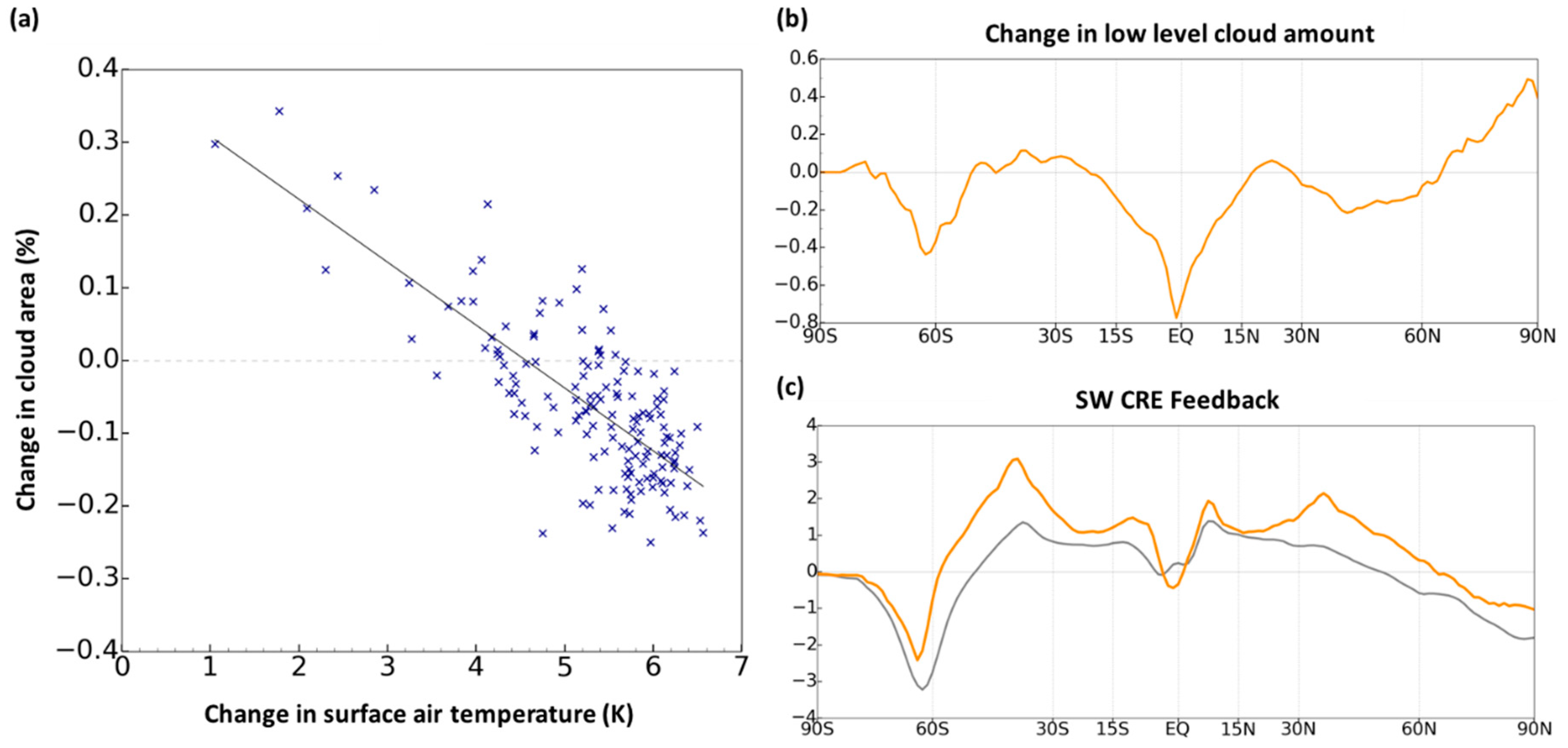
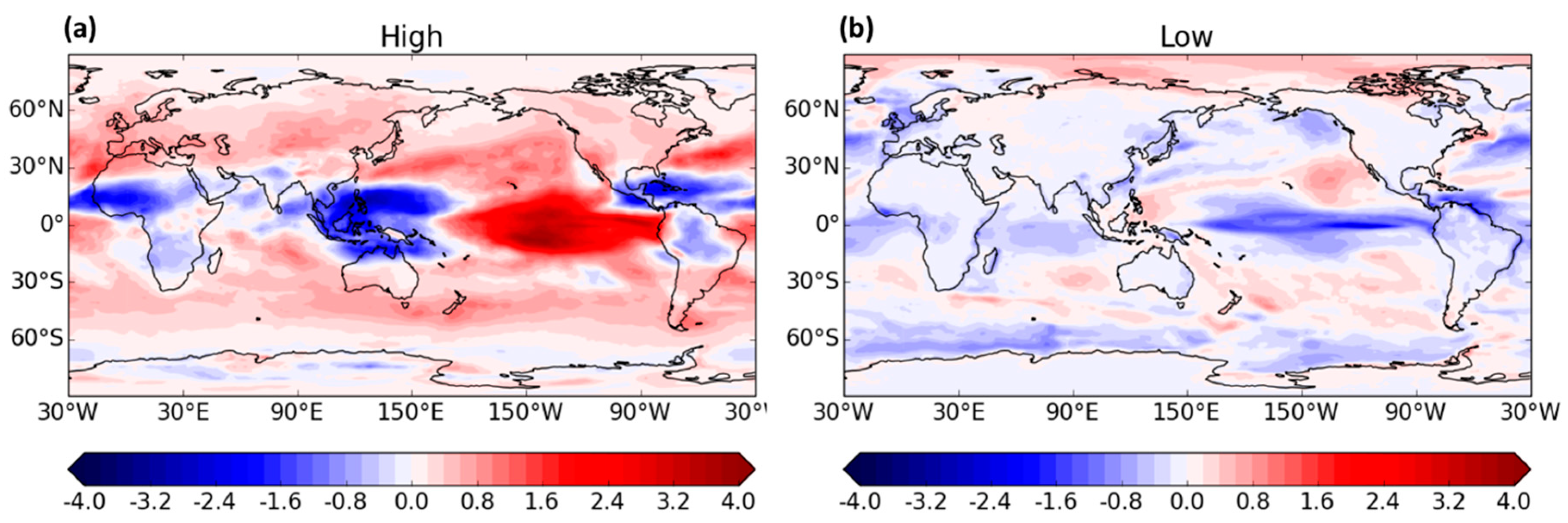
Publisher’s Note: MDPI stays neutral with regard to jurisdictional claims in published maps and institutional affiliations. |
© 2020 by the authors. Licensee MDPI, Basel, Switzerland. This article is an open access article distributed under the terms and conditions of the Creative Commons Attribution (CC BY) license (http://creativecommons.org/licenses/by/4.0/).
Share and Cite
Sun, M.-A.; Sung, H.M.; Kim, J.; Boo, K.-O.; Lim, Y.-J.; Marzin, C.; Byun, Y.-H. Climate Sensitivity and Feedback of a New Coupled Model (K-ACE) to Idealized CO2 Forcing. Atmosphere 2020, 11, 1218. https://doi.org/10.3390/atmos11111218
Sun M-A, Sung HM, Kim J, Boo K-O, Lim Y-J, Marzin C, Byun Y-H. Climate Sensitivity and Feedback of a New Coupled Model (K-ACE) to Idealized CO2 Forcing. Atmosphere. 2020; 11(11):1218. https://doi.org/10.3390/atmos11111218
Chicago/Turabian StyleSun, Min-Ah, Hyun Min Sung, Jisun Kim, Kyung-On Boo, Yoon-Jin Lim, Charline Marzin, and Young-Hwa Byun. 2020. "Climate Sensitivity and Feedback of a New Coupled Model (K-ACE) to Idealized CO2 Forcing" Atmosphere 11, no. 11: 1218. https://doi.org/10.3390/atmos11111218
APA StyleSun, M.-A., Sung, H. M., Kim, J., Boo, K.-O., Lim, Y.-J., Marzin, C., & Byun, Y.-H. (2020). Climate Sensitivity and Feedback of a New Coupled Model (K-ACE) to Idealized CO2 Forcing. Atmosphere, 11(11), 1218. https://doi.org/10.3390/atmos11111218




